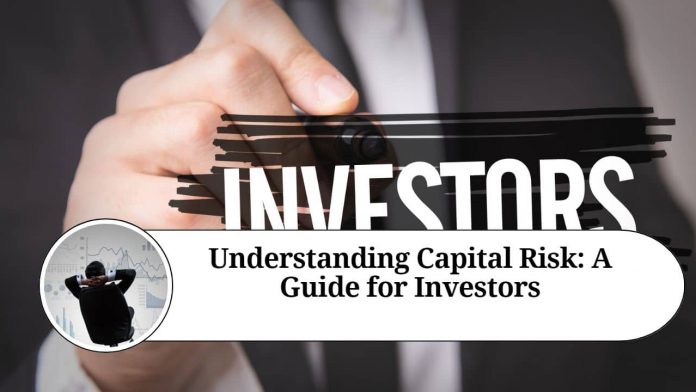Capital risk is the possibility that an investment will result in a loss of the principal amount. It is a critical concept in the world of finance, as it helps investors to evaluate the risk-reward tradeoff of their investment decisions. Understanding capital risk is essential for investors who seek to build wealth through financial markets, as it can help them to avoid potential pitfalls and protect their capital.
Capital risk can arise in a variety of investment vehicles, including stocks, bonds, mutual funds, and real estate. In general, the higher the potential return of an investment, the higher the risk of capital loss. For example, stocks of emerging market companies can offer higher returns, but also carry a higher degree of risk than established blue-chip stocks.
There are several factors that can contribute to capital risk, including market volatility, economic uncertainty, geopolitical risks, and changes in industry trends. For example, if there is a sudden economic downturn, stock prices may fall sharply, causing investors to lose a significant portion of their investment.
To manage capital risk, investors can take several measures. One approach is diversification, which involves spreading investments across multiple assets or asset classes. By diversifying their portfolio, investors can reduce the impact of any single asset’s decline on their overall portfolio. Another approach is to use risk management tools, such as stop-loss orders or hedging strategies, to limit the downside risk of investments.
Investors should also be aware of their risk tolerance, which is their ability to withstand losses without compromising their financial goals. Generally, investors with a high risk tolerance can tolerate more capital risk, while those with a low risk tolerance should focus on low-risk investments, such as bonds or savings accounts.
One of the most significant benefits of understanding capital risk is that it allows investors to make informed investment decisions. Investors who are aware of the risks involved in an investment are better equipped to make decisions that align with their financial goals and risk tolerance.
For example, an investor with a low risk tolerance may prioritize investments that offer stable returns and are less likely to experience significant capital losses. In contrast, an investor with a higher risk tolerance may prioritize investments that offer the potential for higher returns, even if they come with a higher risk of capital loss.
Another key consideration when it comes to capital risk is the time horizon of an investment. Long-term investors, such as those investing for retirement, may be more willing to tolerate short-term capital losses in exchange for the potential for long-term growth. Short-term investors, such as those investing to meet a specific financial goal, may prioritize investments that offer greater stability and less capital risk.
Finally, it is worth noting that capital risk is not the same as volatility. Volatility refers to the magnitude of price swings in an asset, while capital risk refers to the potential for permanent loss of capital. While volatility can be a source of capital risk, not all volatility results in capital risk. Investors should be aware of the difference between these two concepts when evaluating their investments.
Conclusion
In conclusion, capital risk is an essential concept for investors to understand. It allows investors to make informed decisions about their investments, manage their risk exposure, and protect their capital. By taking steps to manage capital risk, investors can build a portfolio that aligns with their financial goals and risk tolerance, and ultimately, achieve greater financial success over the long term.
Other Related Blogs: Section 144B Income Tax Act
Frequently Asked Questions (FAQs)
Q: What is capital risk?
A: Capital risk is the potential for an investment to result in a loss of the principal amount.
Q: What are some examples of investments that carry capital risk?
A: Investments that carry capital risk include stocks, bonds, mutual funds, and real estate. Generally, the higher the potential return of an investment, the higher the risk of capital loss.
Q: What are some factors that can contribute to capital risk?
A: Factors that can contribute to capital risk include market volatility, economic uncertainty, geopolitical risks, and changes in industry trends.
Q: How can investors manage capital risk?
A: Investors can manage capital risk by diversifying their portfolio, using risk management tools such as stop-loss orders or hedging strategies, and being aware of their risk tolerance.
Q: What is the difference between capital risk and volatility?
A: Capital risk is the potential for permanent loss of capital, while volatility refers to the magnitude of price swings in an asset. While volatility can be a source of capital risk, not all volatility results in capital risk.
Q: What is risk tolerance?
A: Risk tolerance is an investor’s ability to tolerate losses without compromising their financial goals. Generally, investors with a high risk tolerance can tolerate more capital risk, while those with a low risk tolerance should focus on low-risk investments.
Q: How does an investor’s time horizon affect their exposure to capital risk?
A: An investor’s time horizon can affect their exposure to capital risk. Long-term investors may be more willing to tolerate short-term capital losses in exchange for the potential for long-term growth, while short-term investors may prioritize investments that offer greater stability and less capital risk.
Q: Why is it important for investors to understand capital risk?
A: Understanding capital risk is important for investors because it allows them to make informed investment decisions, manage their risk exposure, and protect their capital. By taking steps to manage capital risk, investors can build a portfolio that aligns with their financial goals and risk tolerance, and ultimately achieve greater financial success over the long term.




















